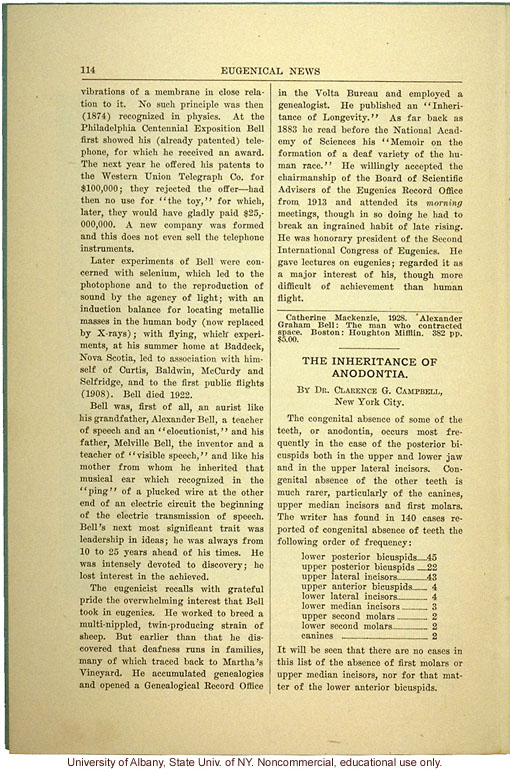"Alexander Graham Bell as Chairman of the Board of Scientific Directors of the Eugenics Record Office," Eugenical News (vol. 14:8) (1)

"Alexander Graham Bell as Chairman of the Board of Scientific Directors of the Eugenics Record Office," Eugenical News (vol. 14:8) (1)
1441. 114 Eugenical News[score] vibrations of a membrane in close relation to it. No such principle was then recognized in physics. At the Philadelphia Centennial Exposition Bell first showed his (already patented) telephone, for which he received an award. The next year he offered his patents to the Western Union Telegraph Co. for $100,000; they rejected the offer - had then no use for "the toy," for which, later, they would have gladly paid $25,000,000. A new company was formed and this does not even sell the telephone instruments. Later experiments of Bell were concerned with selenium, which led to the photophone and to the reproduction of sound by the agency of light; with an induction balance for locating metallic masses in the human body (now replaced by X-rays); with flying, which experiments, at his summer home at Baddeck, Nova Scotia, led to association with himself of Curtis, Baldwin, McCurdy and Selfridge, and to the first public flights (1908). Bell died in 1922. Bell was, first of all, an aorist like his grandfather, Alexander Bell, a teacher of speech and an "elocutionist," and his father, Melville Bell, the inventor and a teacher of "visible speech," and like his mother from whom he inherited that musical ear which recognized in the "ping" of a plucked wire at the other end of an electrical circuit the beginning of the electric transmission of speech. Bell's most significant trait was leadership in ideas; he was always from 10 to 25 years ahead of his times. He was intensely devoted to discovery; he lost interest in the achieved. The eugenicist recalls with grateful pride the overwhelming interest that Bell took in eugenics. He worked to breed a multi-nippled, twin-producing strain of sheep. But earlier than that he discovered that deafness runs in families, many of which traced back to Martha's Vineyard. He accumulated genealogies and opened a Genealogical Record Office in the Volta Bureau and employed a genealogist. He published an "Inheritance of Longevity." As far back as 1883 he read before the National Academy of Sciences his "Memoir on the formation of a deaf variety of the human race." He willingly accepted the chairmanship of the Board of Scientific Advisers of the Eugenics Record Office from 1913 and attended its [begin italics]morning[end italics] meetings, though in doing so he had to break an ingrained habit of late rising. He was honorary president of the Second International Congress of Eugenics. He gave lectures on eugenics; regarded it as a major interest of his, though more difficult of achievement than human flight. [score] Catherine Mackenzie, 1928. Alexander Graham Bell: The man who contracted space. Boston: Houghton Mifflin. 382 pp. $5.00. [centered score] The Inheritance of Anodontia. By Dr. Clarence G. Campbell, New York City. The congenital absence of some of the teeth, or anodontia, occurs most frequently in the case of the posterior bicuspids in the upper and lower jaw and in the upper lateral incisors. Congenital absence of the other teeth is much rarer, particularly of the canines, upper median incisors and first molars. The writer has found in 140 cases reported of congenital absence of teeth the following order of frequency: lower posterior bicuspids . . .45 upper posterior bicuspids . . .22 upper lateral incisors . . .43 upper anterior bicuspids . . .4 lower lateral incisors . . .4 lower median incisors . . .3 upper second molars . . .2 lower second molars . . .2 canines . . .2 It will be seen that there are no cases in this list of the absence of first molars or upper median incisors, nor for that matter of the lower anterior bicuspids. [end]
- ID: 11400
- Source: DNALC.EA


